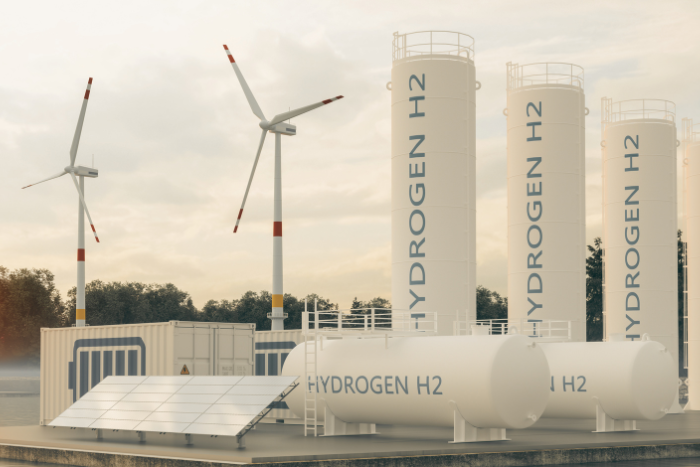New report highlights a $180 billion opportunity for hydrogen electrolysers in key Asian markets by 2050, with India achieving highest growth at $78 billion by 2050
According to a new report, the market potential for green hydrogen (H2) electrolysers in India is estimated to reach $78 billion by 2050, up from $4 billion in 2030. The report assessed the future potential and trajectory for electrolysers needed to meet green H2 demand in China, India, Japan, and South Korea.
Net-zero targets in Asia’s four largest economies could substantially expand the market for green hydrogen electrolysers, with the combined potential in these countries projected to reach $180 billion by 2050 for key industrial applications, according to Green Hydrogen for Decarbonising Asia’s Industrial Giants.
The study looked at the role of green H2 in three priority industries—steel, ammonia, and methanol—under various decarbonisation scenarios. In these sectors, green H2 has the capacity to significantly reduce emissions by replacing carbon-intensive processes with renewable energy-powered electrolysis.
Market potential in Asia: $180 billion by 2050
The report projected massive growth in the market potential of green H2 electrolysers for the three industries by 2050 should the four countries adhere to their declared net-zero targets. According to the figures, the potential in China could go to $85 billion by 2050, up from $22 billion in 2030; in India it could reach $78 billion by 2050, up from $4 billion in 2030; in Japan it could reach $9 billion by 2050, up from $1 billion in 2030 and in South Korea it is estimated to reach $8 billion by 2050, up from $1 billion in 2030.
Thus, it is anticipated that the total market potential for electrolysers will soar to $180 billion by 2050, with a compound annual growth rate of up to 12% between 2030 and 2040. This exceeded the market potential in a business-as-usual situation by over five times. Because electrolysers have uses in other industries, the overall market opportunity will be substantially larger.
The report said technological improvements, government policies, investments in renewable infrastructure, and higher output objectives under net-zero commitments are driving this expansion. China’s and India’s aggressive hydrogen targets are reflected in their substantial projected outputs of 112 million metric tonnes (Mt) and 125 Mt of green H₂-DRI steel, 25.5 Mt and 25.8 Mt of green ammonia, and 38 Mt and 8 Mt of green methanol, respectively, by 2050, while Japan and South Korea are expected to have more moderate production figures due to challenges in domestic renewable electricity generation.
The ammonia and methanol industries are two of the largest consumers of H₂, which is currently produced from fossil fuels (natural gas or coal). The use of green H₂ as a reductant in the iron and steel industry is an emerging application of H₂ that can substantially contribute to the decarbonisation of this sector.
Green H₂ is produced by water electrolysis using renewable energy sources, and it can be utilised as a reductant and carbon-free feedstock to drastically lower carbon emissions in a number of important industry sectors. At the moment, coal gasification or steam methane reforming from natural gas provide a majority of the world’s hydrogen generation.
Ways to actualise the potential
The report urged the policymakers to develop guidelines for hydrogen use in industry so that it can be strategically deployed for maximum decarbonisation impact. Implementing regulatory frameworks to support the adoption and development of green hydrogen technologies, investing in R&D to enhance efficiency and reduce costs of electrolysers, creating financial incentives to stimulate the green hydrogen market and local manufacturing, and promoting international cooperation to share knowledge and standardise practices in the hydrogen economy were some of the recommendations made by the report specifically for the policymakers.
For industry, the report recommended expanding manufacturing capabilities to meet the growing demand for electrolysers, innovating in product development to create more efficient and cost-effective electrolyser technologies, strengthening supply chains to ensure the availability of essential materials and components and enhancing collaboration to integrate green hydrogen solutions across various sectors, among other steps.
For investors, the report recommended supporting high potential projects with innovative technology. Other recommendations included promoting risk-sharing mechanisms to facilitate investment in early-stage projects, evaluating long-term market potential to sustain investment decisions with a focus on decarbonisation and investing in green hydrogen infrastructure to build the necessary framework for hydrogen production and distribution.
About The Author
You may also like
India’s EV revolution: Are e-rickshaws leading the charge or stalling it?
India’s solar output grows at slowest pace in six years in first half of 2024
India to bear the highest cost globally as climate change increases women’s water collection burden
India’s solar expansion threatened by transformer shortage
Air pollution leading risk factor for death in South Asia, killed 2.6 million in 2021: Report


